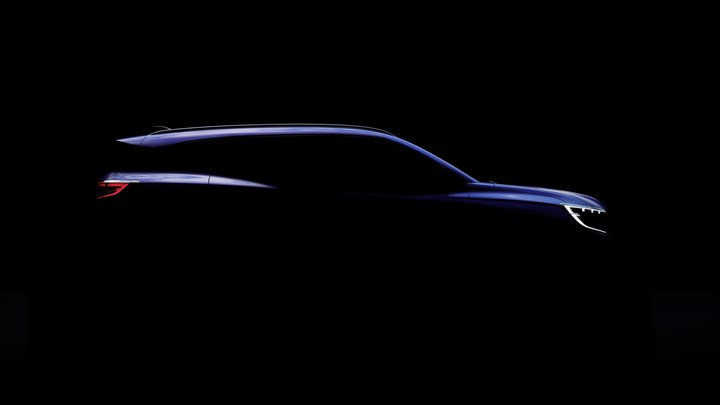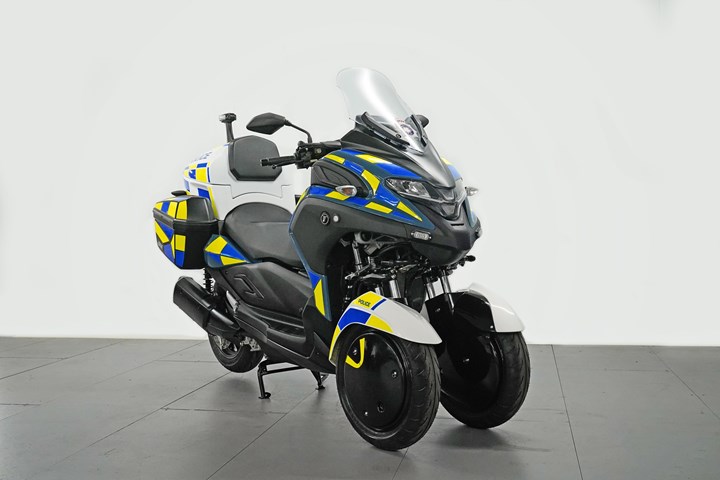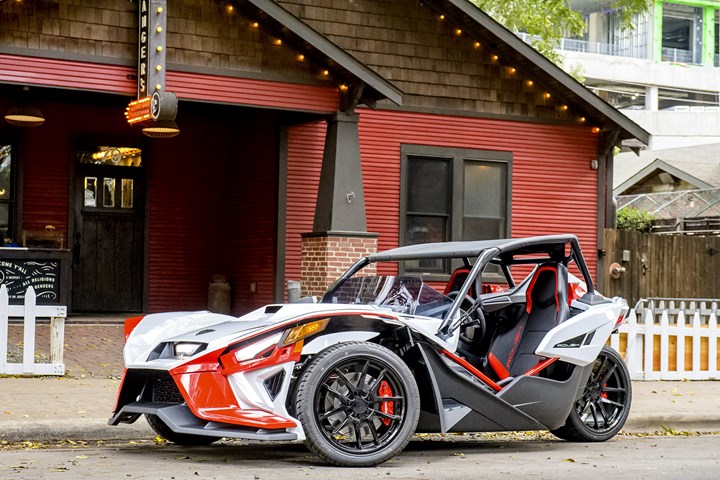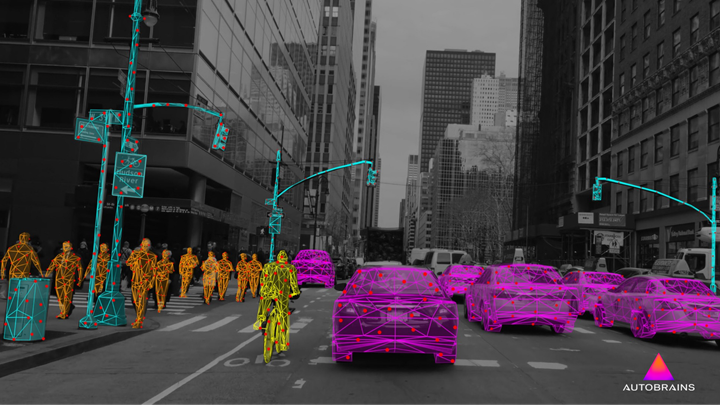on Rivian, ICEs, Three-wheelers, AI for autonomous driving, Honda Pilot
Rivian is still gaining traction. . .Renault, Geely and Amoco don’t think ICEs are done. . .three-wheelers for vastly different applications. . .Honda’s rugged SUV. . .
Rivian: People Like Them (But There Aren’t Enough Vehicles Yet)

Marriage of the R1T tophat and the skateboard at the Rivian factory in Normal, Illinois. (Image: Rivian)
“Supply chain continues to be the main limiting factor of our production; during the quarter we encountered multiple days of lost production due to supplier shortages. We expect supply chain challenges to persist into 2023 but with better predictability relative to what was experienced in 2022.”—from the Rivian Q4 2022 Shareholder Letter
Last year Rivian produced 24,337 vehicles in its plant in Normal, Illinois, which is short of the 25,000 it had anticipated for the 2022 calendar year.
That said, it is notable that in Q4 it boosted production by 36%. At the end of Q3 ’22 it had produced 14,317, so they were busy in the factory.
Its production target for 2023: 50K units.
(And speaking of the factory: check out this video of the plant. Most impressive.)
The EV Pickup
Good news for Rivian last week was that its R1T (the pickup) finished first in the Premium category of the J.D. Power 2023 U.S. Electric Vehicle Experience Ownership Study.
It received a score of 794 out of 1,000.
The Tesla Model 3 came in second at 759 and the Model Y was at 754.
(In the Mass Market category, the MINI Cooper Electric had 782 points, besting the Kia EV6 with 762 and Ford Mustang Mach-E with 742.)
The study is for vehicles in the first year of ownership and looks at 10 factors: accuracy of stated battery range; availability of public charging stations; battery range; cost of ownership; driving enjoyment; ease of charging at home; interior and exterior styling; safety and technology features; service experience; and vehicle quality and reliability.
==
*Here’s something interesting: one of the reasons people say they’re not interested in an EV is because to limited range compared with ICE vehicles. Consequently, OEMs are putting in bigger batteries to boost the range (and which also boosts the price). Yet a 2023 MINI Cooper SE has an EPA estimated range of just 114 miles, which many find to be ridiculously low, but there it is at the top of its category. The EV6 has a base range of 206 miles and the Mach-E an EPA-estimated 247-mile range—more than twice that of the MINI.
///
“Get a Horse!”

Forthcoming Renault Espace. (Image: Renault)
Horse.
Maybe that name has more resonance in France and/or China, but last November, in announcing an organizational restructuring into five focused business units, Renault Group indicated that its “traditional core business” of making internal combustion engines, supplemented by hybrids, would be named “Power” and continue to develop powertrains. . .and it was creating a 50-50 joint venture supplier company with Geely: Horse.
In that announcement the companies noted:
“The new company is planned to operate 17 powertrain plants in 3 continents, employing around 19,000 people in total. It will have a combined capacity of over 5 million internal combustion, hybrid and plug-in hybrid engines and transmissions per year, supplying over 130 countries and regions. The new company's joint product portfolio and regional footprint could offer solutions for 80% of the global ICE market.”
And as part of its Capital Markets Day presentation Renault pointed out:
“ICE & hybrid vehicles will still represent up to 50% of passenger car sales worldwide even by 2040.”
(Yes, yes, it also announced its EV and software-defined vehicle businesses, and mobility and closed-loop recycling businesses.)
Lots of Cars
According to statistics from the International Organization of Motor Vehicle Manufacturers, in 2021 (most recent data) there were 57,054,295 cars produced globally.
So one assumes that by 2040, there will be a lot of ICEs needed.
“But wait,” you say. “Aren’t places like the European Union countries and California planning to or outright banning new ICE vehicle sales by 2035?”
True, but EU countries including Germany and Italy are pushing back on that (and a vote that was to take place this week by the EU ministers has been delayed. Unless something radically happens in California, odds are that’s not going to be an issue.).
The Germans (and particularly some German car companies) are interested in making e-fuels part of a carbon-neutral transportation plan.
Which brings us back to the Renault-Geely joint venture.
Last week a letter of intent was signed by a potential minority stakeholder in Horse* (which may have gone away as a name since it is now generally referred to without a specific title):
Aramco
Yes, the company that is big in petrochemicals.
Luca de Meo, CEO of Renault Group, said of the likely new investor:
“This partnership with Aramco will raise our joint powertrain company together with Geely Group to the next level and give it a head start in the race towards ultra-low-emissions ICE powertrain technology. Aramco’s entry brings to the table unique know-how that will help develop breakthrough innovations in the fields of synthetic fuels and hydrogen.”
The Point
To be sure, there is a growing number of electric vehicles and that number will continue to rise.
But while there will be fewer ICEs being built, this doesn’t mean that come the middle of the next decade or at the start of the decade after that the ICE number will fall to zero.
Remember, the drive to EVs is as much about politics as it is about the environment, so it would be naïve to imagine that rules, regulations and laws won’t change as politicians do.
==
*Speaking of horses, according to an article in Scientific American published in 2017: “In one decade, cars replaced horses (and bicycles) as the standard form of transport for people and goods in the United States.” The decade was from 1907 to 1917, when there were a 33-fold increase in cars registered and 134-fold increase in commercial, ag and military vehicles in the U.S. While some equate ICE vehicles to horses and EVs to the more modern form of transportation, clearly the growth curve for EVs is not nearly as dynamic as it was for the Model T and its compatriots back in their day.
///
Engineering Electric Police Trikes

British 5-0 on three wheels. And going hybrid. (Image: MAHLE)
“Existing electric motorcycles have been designed with the retail market in mind, and can be both expensive and slow to charge.
“Because emergency services require high levels of availability and have an unpredictable demand, retail electric motorcycles are unlikely to present a cost-effective solution.”--Jonathan Hall, MAHLE Powertrain’s Head of Research and Advanced Engineering.
So MAHLE Powertrain is working with White Motorcycle Concepts (WMC) in the U.K. on a program to transform the Yamaha Tricity 300 three-wheel motorcycle into an EV.
WMC has developed the WMC300FR, a hybrid, with the Northamptonshire Police. This program will remove the internal combustion engine.
An interesting aspect of the development program is that MAHLE Powertrain is extensively using simulation.
Engineers are using real-world data as inputs to the virtual environment.
They will investigate aspects including the traction motors, charger systems and battery topologies. There are also packaging studies, including how to integrate the traction motor and transmission into a new rear swing arm.
Trikes?
“The hybrid three-wheeled bikes we now have in our fleet are providing an alternative, practical and very visible way for our neighbourhood police officers to get out and about in their communities. We need to continue to ensure we are prepared for the future with a sustainable fleet that not only meets the green agenda but also enables us to deliver the policing service our communities need and want.”--Northamptonshire Police Chief Constable and UK Police lead for Motorcycles, Nick Adderley
///
Not Your Childhood Trike

Quick and. . .baroque. (Image: Polaris)
Speaking of three-wheelers. . .
Around the Detroit Metro (and presumably elsewhere) it is not uncommon to see things like F-150s and Mustangs that require a double take because the logos in the front or back read “ROUSH.” These are vehicles that have been transformed by Roush, an automotive company that does everything from designing and engineering to manufacturing—and through its Roush Performance company makes incredibly fast vehicles.
It is worth knowing that it isn’t coincidental that those performance vehicles are Fords: Roush World Headquarters is literally across the street from the Ford Livonia Transmission Plant and about 20 minutes away from Ford HQ.
There is another vehicle that has been given the Roush treatment, this one which is, well, somewhat unusual.
It is the 2023 Polaris Slingshot ROUSH Edition.
A three-wheeler from the company that is known for its snowmobiles, side-by-sides, Indian motorcycles, and the three-wheel Slingshot (two in the front, one in the back).
The ROUSH special edition is powered by a 203-hp, 2.0-liter four. The curb weight is 1680 pounds. Which means 8.1 lb/hp. It is limited to 125 mph.
Features include Brembo brakes, Sparco pedal covers, Roush seats, special graphics, and more.
Chris Sergeant, Polaris Slingshot Vice President:
“We wanted to design a ride that authentically reflects ROUSH's trusted heritage in performance, but remained true to the wow-factor, adventure-seeking lifestyle only Slingshot provides, and the Slingshot ROUSH Edition delivers on those promises.”
Given the styling, “wow” is one grammatical interjection.
We can think of others.
(The styling of the 2022 ROUSH 450R Mustang, on the other hand, is jaw-droppingly impressive.)
///
Affordable Vehicular Automation: A Neural Net Approach for Efficiency

Autobrains is developing AI for autonomous driving that is, the company claims, efficient, capable and affordable. (Image: Autobrains)
There are several things to take into account when considering various levels of driver assistance working up toward self-driving. To be sure, the technical aspects are first and foremost.
But Joachim Langenwalter, senior vice president of autonomous driving for Autobrains, a company developing AI systems for applications from ADAS on up, makes an argument that is probably more germane to the proliferation of these systems than any number of commercials showing people clapping their hands while behind the wheel: Economics.
Langenwalter is probably highly aware of this aspect because prior to joining Autobrains last month he had been head of engineering responsible for hardware and software engineering at Stellantis (with a portfolio including autonomous driving, smart cockpit and connected services programs) and before that vice president of software strategy for Volkswagen.
He is cognizant of the cost considerations when it comes to technology implementation in auto.
Langenwalter also spent time at NVIDIA as director of automotive software, so he understands systems on a chip (SoCs) that operate at multiple trillions of operations per second (TOPS).
Cost Calculations
So when you ask him about the deployment of advanced systems for vehicular automation, he turns to factors including total production costs (what is the OEM paying to develop and produce the tech) and the customer take rate. And he says that the way most AI companies are developing their systems—a methodology called “supervised learning”—is expensive, which means that the OEMs have to charge more, which means consumers are going to buy less.
He says that what Autobrains is doing is developing a system that is “significantly cheaper”—as in “three-digit millions” less expensive—than is achievable by the supervised approach and, importantly, “explainable” vs. what is considered to be a “black box approach” (i.e., you know what’s going into the box, you see what comes out of the box, but you don’t know how the inputs were turned into the outputs—to put it simply).
Nils Berkemeyer, Autobrains vp of Corporate Development, came to Autobrains with a background in venture capital; he had been the co-founder and investment partner at Continental Ventures, the VC arm of supplier Continental, which was an early investor in Autobrains (BMW i Ventures and Toyota Ventures are among the strategic investors in the company).
Like a Brain
He explains that the approach that they are using to develop autonomous driving functionality is analogous to the way the brain works. (Berkemeyer says that the original work came out of The Technion, Israel Institute of Technology, a project on the intersection between biochemistry and data science.)
Berkemeyer says that in traditional approaches to training a system for autonomous driving includes capturing images—billions of them—from cameras and then labeling them.
Autobrains still needs the images but it doesn’t need the labels: it organizes the images into generic groups that are indexed and compressed into neural responses. These are referred to as “signatures.” This approach is one that is being used in other areas, such as natural language processing and by social media companies.
Rather than supervised learning, the approach taken is self-learning. But what is also important (going back to that black box) is that this approach, Berkemeyer says, allows the ability for something that led to a misclassification to be identified in a “very straightforward way,” and for the root cause to be “surgically removed” and replaced without the need for refeeding the entire system.
Another aspect of the affordability of the system goes to the point of the hardware, sensors and processors. On the sensor front, the company is agnostic.
Efficient Processing
And in terms of the processor, Langenwalter says the software stack can run efficiently on a SoC that doesn’t need as high processing capabilities as some of the premium units that are being put on the market.
Berkemeyer says there is a Level 2 ADAS system that is currently running on a 5 TOPS chip and that the Autobrains approach can provide the same capability on 1-TOPs.
Which goes back to the point of reduced cost.
Langenwalter is reticent to put a date certain as to when there will be vehicles in volume on the road with higher levels (>L2+) of autonomous capabilities.
But one thing he is certain about is that it isn’t going to happen—at least not outside luxury vehicles—until an economic case can be made.
And at Autobrains, not only are they working on developing the technology, but also being highly cognizant of making it something useful, beneficial, capable. . .and affordable.
///
2023 Honda Pilot TrailSport AWD

The Honda Pilot TrailSport does more than just drive in the dirt. (Image: Honda)
If you’ve seen a Honda TV commercial of late, you’ve probably noted that the company is not emphasizing its Accords and Civics doing urban and suburban commuter duty but its range of vehicles that are more likely to be seen in Home Depot parking lots and at trailheads.
And as for the latter location, there is the 2023 Pilot TrailSport which, according to Honda was tested on the rocks at Moab, Utah, and in the sand at Glamis, California, and presumably because it is built in Alabama, took to some trails in both Kentucky and North Carolina.
The TrailSport is a variant of the fourth-generation Pilot, which Honda describes as the “largest and most powerful SUV in Honda history.”
All-terrain Tires & Skid Plates
In terms of size, the TrailSport variant is 200.2 inches long, 72 inches high, 78.5 inches wide, and has a 113.8-inch wheelbase. It rides on 18-inch Continental TerrainContact AT all-terrain tires. This is the first Honda SUV offered with all-terrain tires from the factory.
Underlying the fact that this is more than having seats embossed with the trim’s name and a use of orange stitching, there are steel skid plates that were engineered in consultation with the folks from Honda Powersports (the people who produce things like side-by-sides that go bashing around the wilds). The plates protect the oil pan, transmission and gas tank.
On the inside, there are 154.9 cubic feet of passenger volume per the EPA, and using the SAE J1100 cargo volume measurement method, 18.6 cubic feet behind the third row, 48.5 cubic feet behind the second row with the third folded and 87 cubic feet, behind the first row with the second and third folded, standard.
As for the power, there is an all-new 3.5-liter V6 (also made in Lincoln, Alabama). The all-aluminum engine produces 285 hp and 262 lb-ft of torque.
It is mated to a 10-speed automatic with paddle shifters.
Handling Off-road Situations
The Pilot brings Honda’s second-generation AWD system to the market, the i-VTM4 system.
There is a selectable “Trail Mode” (let’s face it, you’re not always off road) that adjusts the performance of the system so that if the vehicle happens to be in a situation where there is one tire on the ground and one in the air, up to 75% of the tire with the traction gets the torque—but, importantly, the remaining torque goes to the tire without torque, thereby making it ready to go when it returns to earth.
Speaking of figuring out where things are in space (key when you’re not on pavement), there is the “TrailWatch” camera system that uses four exterior camera that provide imagines of what’s what when in Trail Mode and driving at speeds under 15 mph. When that speed is exceeded, then the cameras shut off (as there is the assumption that if you’re driving at that speed you don’t need them). But what’s nice about this system is that should the SUV then go below 12 mph the TrailWatch system cameras are reactivated. (I’ve had the opportunity to be offroad in another brand’s vehicle with a similar system and found it necessary to having to manually reactivate after exceeding its speed limit, which was not only tedious but troublesome because when I needed the view, I needed it.)
And, yes, this three-row SUV can tow, up to 5,000 pounds.
The all-new Pilot comes in five trims, Sport, EX-L, Touring, Elite, and TrailSport, and with FWD, AWD, and seating variants within them.
Odds are, most people aren’t going to need those tires and skid plates. Odds are, most people would be happier with the plusher amenities of the Touring, which is just $200 more than the MSRP of the TrailSport, which is $48,350.
Still, Honda has the capable variant for those so inclined.
RELATED CONTENT
-
How to Build a Military Vehicle from a Pickup Truck
A real piece of military gear. A real pickup that you can get at a Chevy dealership. A really remarkable story.
-
On Automotive: An All Electric Edition
A look at electric vehicle-related developments, from new products to recycling old batteries.
-
Aluminum Sheet for EV Battery Enclosure
As the number of electric vehicles (EVs) is about to increase almost exponentially, aluminum supplier Novelis is preparing to provide customers with protective solutions


.jpg;width=70;height=70;mode=crop)






